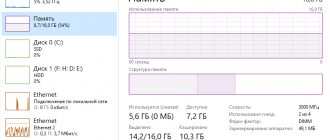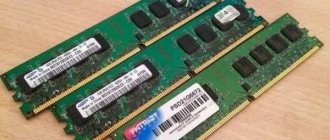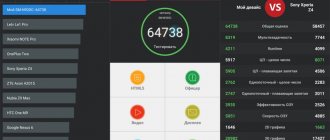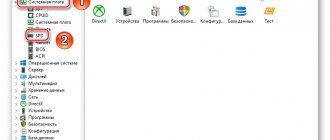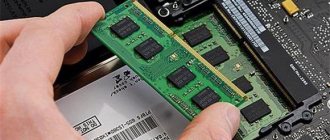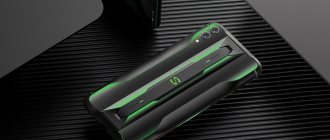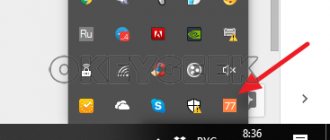Method 3. Use “Device Manager”
There are many options to get into the Device Manager window. One of them:
- On the “My Computer” icon, click the right side of the mouse button and open a window in which we select the bottom line called “Properties”.
Select the line called “Properties” - The window that opens will contain incomplete information about your computer, and the line called “System” contains information about random access memory (RAM).
The line called “System” contains information about random access memory (RAM)
Video - What RAM is installed on my PC
Determining the amount of memory using Windows
First, let's determine the amount of RAM without third-party programs using the built-in Windows tools.
Option 1. System properties
Hover your cursor over the This PC or Computer and right-click. In the menu that opens, select - Properties .
Entering system properties in Windows 7
Windows 7 System Properties - 8 GB Memory Installed
Profitable PC builds and upgrades in the VK group - https://vk.com/ruslankomp
PC upgrade and assembly services - leave a request in the VK group
Option 2: Task Manager
On Windows 10, the easiest way to check how much RAM is through Task Manager .
Press the hotkey combination Ctrl+Shift+Esc - press and hold Ctrl+Shift and then press Esc and release all keys.
Hot keys ctrl+shift+esc
A window will appear - Task Manager . Click on the More details if the window appears minimized.
Windows 10 Task Manager
Go to Performance - Memory as shown below.
Windows 10 Task Manager - 8GB RAM
The amount of RAM is shown in the upper right corner - 8 GB.
Hence the conclusion: the laptop has 1 8 GB slot installed.
In Windows 7, the task manager is also called up using the Ctrl+Shift+Esc , but it looks different.
Open the Performance and in the Physical memory you will see how much RAM is on the computer.
Windows 7 Task Manager, 8 GB RAM
Option 3: Command Line
To open the command line:
- Press Win+R .
- Type -cmd and press Enter .
Launch the Run line using the Win+R keys
CMD - launch command line
In the command line, paste the command:
wmic MEMORYCHIP get BankLabel,DeviceLocator,Capacity,Speed
Windows Command Line - Capacity (RAM size) 8 GB
- BankLabel - indicates the number of the connector on the board to which the RAM stick is connected.
- Capacity - the amount of RAM in kilobytes. From the first number it is not difficult to guess how much it will be in GB.
- DeviceLocator - connection slots.
- Speed — RAM frequency in MHz. In this case, the memory operates at a frequency of 2133 MHz.
What are the main characteristics of RAM and why know them?
So, the more RAM, the better, and that is why users often install an additional RAM module on their PC. However, you can’t just go to the store, buy any memory and connect it to the motherboard. If it is chosen incorrectly, the computer will not be able to work, or worse, it will lead to the fact that the RAM will simply fail. Therefore, it is so important to know its key characteristics. These include:
- Type of RAM. Depending on performance and design features, DDR2, DDR3 and DDR4 modules are distinguished.
- Memory size. The parameter is characterized by the amount of data that can fit in memory cells.
- RAM frequency. The parameter determines the speed of operations performed per unit of time. The bandwidth of the RAM module depends on the frequency.
- Timing. These are time delays between sending a memory controller command and its execution. As the frequency increases, the timings increase, which is why overclocking the RAM can lead to a decrease in its performance.
- Voltage. The voltage required for optimal operation of the memory stick.
- Form factor. The physical size, shape of the RAM stick, as well as the number and location of pins on the board.
If you install additional memory, it must have the same size, type and frequency as the main one. If the RAM is completely replaced, attention should be paid to the support of the replaced RAM by the motherboard and processor with only one nuance. If the PC uses Intel Core i3, Intel Core i5, Intel Core i7 processors, matching the memory frequency and the motherboard is not necessary, because for all these processors the RAM controller is located in the processor itself, and not in the northbridge of the motherboard. The same goes for AMD processors.
Serial number
Run CMD as administrator and enter:
- wmic memorychip get devicelocator, serialnumber
- The “SerialNumber” column will show the serial number.
Overall volume
Open a command prompt as administrator and enter:
- systeminfo | findstr /C:"Total Physical Memory" (does not always work due to the chip).
- wmic ComputerSystem get TotalPhysicalMemory (if above doesn't work).
What is computer RAM
You can (and probably have) come across such names for RAM as RAM - random access memory, RAM, RAM - Random Access Memory. This is one of the most important components of a computer. The purpose of RAM is to temporarily store various information necessary for the operation of the machine: cache, executing program code, driver settings, current parameters, information processed by the CPU, etc.
Physically, the RAM module consists of special sticks placed in special slots on the motherboard.
RAM is volatile and therefore temporary. Let us clarify this point. Every computer has non-volatile memory. These are drives, permanent storage devices. They always store information until it is deleted by the user, even if the machine is disconnected from the network. Volatile memory requires constant power supply. If it stops feeding, all temporary data will disappear from the RAM. A newly turned on computer will work with completely empty RAM, gradually filling it with the information necessary for work.
In system settings
One of the simplest options involves entering Windows Settings. It contains a section “About the system”, which contains information about the amount of installed RAM.
How to get to the required section?
- Click on the Windows logo icon to get to the main Start menu, then go to the Settings category.
- Next we go to the “System” section. To find it, you can enter the word in the search bar.
- The left column shows the different categories. Follow the link labeled “About the system.”
- The right side of the window provides information about the installed and available amount of RAM.
Additionally: if necessary, you can see which video card is on the computer. The ability to run powerful graphic applications and modern games will depend on its characteristics.
How to find out how much RAM is on your computer using msinfo32
The user can quickly obtain data on the amount of RAM in the operating systems Windows 10, Windows 8.1, Windows 8, Windows 7, using the built-in system tool “msinfo32” (“System Information”).
Follow these steps:
- Go to the Start menu.
- In the list of programs, find the “Windows Administrative Tools” folder (in Windows 7, “Utilities”).
- Launch the System Information utility.
- In the System Information window, under Installed RAM, you will see the total amount of memory on your computer.
Results
Which method to choose depends on what exactly you want to know. Perhaps it is enough for you to know the size of your memory (for example, to know how much you need to buy). Or you need to know the frequency, voltage, manufacturer, type, channels and other useful information.
The conclusion can be drawn as follows: finding out this or that information about your RAM is quite simple, but not everyone knows how to do this. This article is intended just to familiarize you with the functions of your system and third-party programs.
I hope you found out what you wanted, all the best!
Piriform Speccy
Finally, let's look at the Piriform Speccy program, which also shows how much RAM is used on your computer. The application has a simple interface, but, unfortunately, is not translated into Russian. However, this is a very small drawback that does not affect the interaction process in any way.
Download and install Piriform Speccy on your PC and then open the program. By default, a window with basic characteristics appears in the application window, but we need to go to the “RAM” tab. All the necessary information will be displayed on the right side of the screen (look for “Total Physical”).
Methods for Mac OS
Finding out the size of RAM on an iMac is also easy. To do this, go to the "Apple" menu - the image of the "apple" in the upper left corner of the screen - and click "About This Mac." In the window that appears, in the “Overview” tab, information about the system will be displayed, one of the items in which will be “Memory”, where information about the amount and type of installed RAM is indicated.
Option 8: View memory in BIOS
If the operating system is not installed or Windows does not boot for various reasons, then the RAM can be viewed in the BIOS.
To do this, when you turn on the PC, press the Delete . If you have a laptop, then in most cases you need to press F2 .
If you do everything correctly, Bios will open and you can see how much RAM is installed.
The amount of RAM in Bios is 16 GB
BIOS RAM capacity - 4 GB
Now you know how to find out how much RAM is installed in a computer or laptop in different ways.
Join my VK group - https://vk.com/ruslankomp
I will help you solve a problem with your PC or laptop. Join the VK group - ruslankomp
What is RAM needed for?
Many novice users ask the question “Why does a computer need RAM if the data on it is lost when the power is turned off? After all, there is a reliable SSD or HDD where information is stored permanently.”
The answer is simple. Compared to the speed of the CPU, the speed of the drive is too slow. If the central processor works directly with the read-only memory, it will greatly reduce the performance of the machine.
RAM, compared to the drive, works much faster. Therefore, the processor receives the data needed for operation much faster, stored in RAM. And thanks to this, computer performance increases.
Methods for Linux
Several commands written in the console (terminal) will help you find out the size of RAM available on a PC with Linux installed. It can be called up using CTRL+ALT+T or by typing “terminal” in the search bar. Let's take a closer look at these commands.
free -m – will show information about the total, free, and currently used RAM.
top – will allow you to view not only the total amount of RAM, but also the amount spent on each running process.
htop - just like the first command, will display all data about the availability and use of RAM.
dmidecode -t 17 – will display data about the installed RAM on the PC (Size – RAM size, Type – type of memory used, Speed – speed).
Determining the amount of memory using programs
Let's look at several options for finding out how much RAM you have using special programs.
Option 4. Speccy
Download the program from the official website - Speccy.
After installing and launching the program, you will see the characteristics of your computer or laptop, including the amount of RAM.
The Speccy program shows that the computer has 8 GB of RAM
If you need detailed information on RAM, then go to the RAM section in the left column.
Speccy program - RAM characteristics
Option 5. Aida64
The next program in which you can determine how much RAM is AIDA64.
Open the Motherboard and click on the memory .
In the right window you will see how much RAM there is.
AIDA64 - RAM capacity 8 GB
For more detailed information on RAM strips, see the section Motherboard - SPD .
AIDA64 characteristics of RAM sticks
Option 6. CPU-Z
Another program that shows the characteristics of PC hardware is CPU-Z.
In the memory tab you will see the entire amount of RAM.
CPU-Z program - 8 GB memory capacity
Option 7. CCleaner
You can also find out how much RAM you have using the program CCleaner.
The CCleaner program not only cleans the system of debris, but also determines the amount of RAM. At the top of the program, you will see the processor model and amount of RAM .
The amount of RAM in the CCleaner program is 8 GB
Content
- How to find out the total memory on your computer
- How to find out RAM characteristics through the command line
- How to find out RAM characteristics via PowerShell
Article in other languages:

